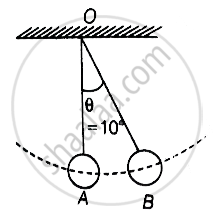Advertisements
Advertisements
Question
Two pendulums with identical bobs and lengths are suspended from a common support such that in rest position the two bobs are in contact (Figure). One of the bobs is released after being displaced by 10° so that it collides elastically head-on with the other bob.

- Describe the motion of two bobs.
- Draw a graph showing variation in energy of either pendulum with time, for 0 ≤ t ≤ 2T, where T is the period of each pendulum.
Solution
a. Consider the adjacent diagram in which the bob B is displaced through an angle θ and released.

At t = 0, suppose bob B is displaced by θ = 10° to the right. It is given potential energy E1 = E. Energy of A, E2 = 0
When B is released, it strikes A at t = T/4. In the head-on elastic collision between B and A comes to rest and A gets the velocity of B. Therefore. E1 = 0 and E2 = E. At t = 27T/4, B reaches its extreme right position when KE of A is converted into PE = E2 = E. Energy of B, E1 = 0.
At t = 3T/4, A reaches its mean position. when its PE is converted into KE = E2 = E. It collides elastically with B and transfers the whole of its energy to B. Thus, E2 = 0 and E1 = E. The entire process is repeated.
b. The values of energies of B and A at different time intervals are tabulated here. The plot of energy with time 0 ≤ t ≤ 2T is shown separately for 8 and A in the figure below.
| Time (t) | Energy of A (E1) |
Energy of B (E2) |
| 0 | E | 0 |
| T/4 | 0 | E |
| 2T/4 | 0 | E |
| 3T/4 | E | 0 |
| 4T/4 | E | 0 |
| 5T/4 | 0 | E |
| 6T/4 | 0 | E |
| 7T/4 | E | 0 |
| 8T/4 | E | 0 |

APPEARS IN
RELATED QUESTIONS
In an inelastic collision of two bodies, the quantities which do not change after the collision are the ______ of the system of two bodies.
State if the following statement is true or false. Give a reason for your answer.
In an elastic collision of two bodies, the momentum and energy of each body is conserved.
Answer carefully, with reason:
In an elastic collision of two billiard balls, is the total kinetic energy conserved during the short time of collision of the balls (i.e. when they are in contact)?
Answer carefully, with reason:
If the potential energy of two billiard balls depends only on the separation distance between their centres, is the collision elastic or inelastic? (Note, we are talking here of potential energy corresponding to the force during collision, not gravitational potential energy.)
Define coefficient of restitution.
Define the following:
Coefficient of restitution
A bullet fired from gun with a velocity 30 m/s at an angle of 60° with horizontal direction. At the highest point of its path, the bullet explodes into two parts with masses in the ratio 1:3. The lighter mass comes to rest immediately. Then the speed of the heavier mass is
Consider a one-dimensional motion of a particle with total energy E. There are four regions A, B, C and D in which the relation between potential energy V, kinetic energy (K) and total energy E is as given below:
Region A : V > E
Region B : V < E
Region C : K > E
Region D : V > K
State with reason in each case whether a particle can be found in the given region or not.
A ball falls from a height of 1 m on a ground and it loses half its kinetic energy when it hits the ground. What would be the total distance covered by the ball after sufficiently long time?
Three identical blocks A, B and C are placed on horizontal frictionless surface. The blocks A and C are at rest. But A is approaching towards B with a speed 10 m/s. The coefficient of restitution for all collision is 0.5. The speed of the block C just after the collision is ______.

